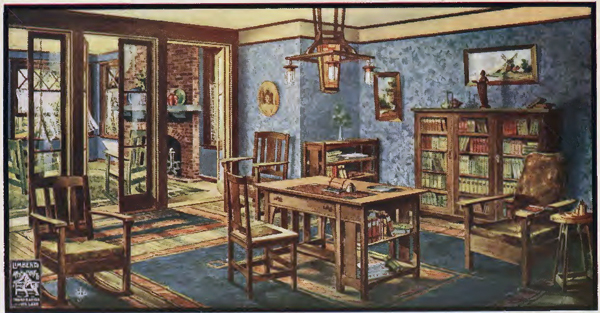
An illustration from one of Limbert’s booklets showing a library furnished with pieces by the company.
Limbert is often dismissed as a copyist of more capable designers, but at his best, he was a capable synthesist, combining diverse elements from European, American, and Japanese design into striking (and sometimes strikingly modern) forms. The sources for his inspiration are wide ranging. His earliest Arts and Craft line shows a debt to the architect Charles Voysey, Dutch folk forms, and Art Nouveau. The later line shows Limbert’s familiarity with the Craftsman furniture produced by Gustav Stickley, the Prairie Style of Frank Lloyd Wright, and the work of Charles Rennie Mackintosh and the Vienna Secessionists. The exposed joinery, rectilinear forms and visual mass of this furniture would not be out of place in the offerings of the many manufacturers responding to the increasing popularity of Craftsman furniture. Some of these designs match or exceed Stickley’s.
As proficient as Limbert was in the Mission vernacular, much of his best work falls into a broader category of Arts and Crafts. Sharing the pages of the 1905 catalog with Mission-influenced work are some of Limbert’s best pieces, those fusing American and European sensibilities. Alloyed in this furniture are the Arts and Crafts emphasis on honest materials and minimal ornamentation with Mackintosh’s use of negative and positive space and the tapered sides of the Vienna Secessionists. The resulting designs are greater than the sum of their parts, yielding unique forms that brought the best of diverse influences together and made them available to the mass market. These designs are also often curiously timeless. Visual rhythm, canted sides and acute angles make the No. 81 hall chair a striking design. In fumed quartersawn oak, it’s at home in a room with other Arts and Crafts furniture. In teak or maple, the chair would not be out of place amidst mid-Century or Dutch modern. Paint it silver or red and the same chair is at home in the most atomic of ranch houses.
Changing tastes prompted Limbert to move away from the Arts and Crafts style to a variety of period reproductions. The adaptation saved the company, but at the cost of Limbert’s unique contribution to the history of furniture. The company’s period reproductions lack the impact of Limbert’s earlier designs, and it those earlier designs that cement Limbert’s legacy as a guiding light of the Arts and Crafts movement in America.
More Information
Bartinique’s sadly out of print Kindred Styles: the Arts and Crafts Furniture of Charles P. Limbert offers the best introduction to Limbert Furniture available.
